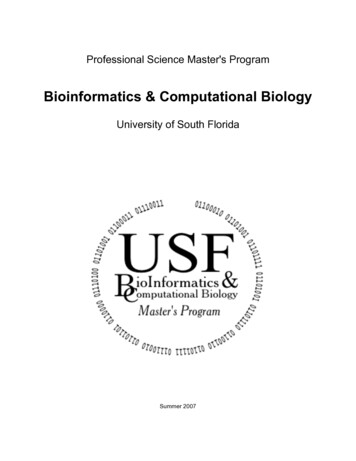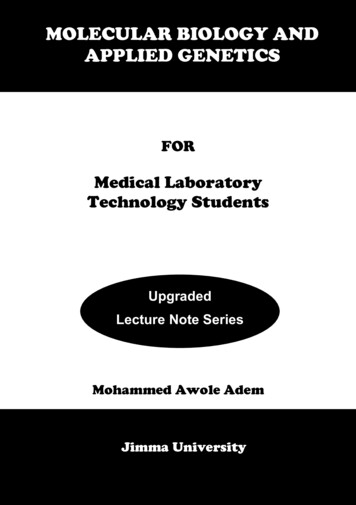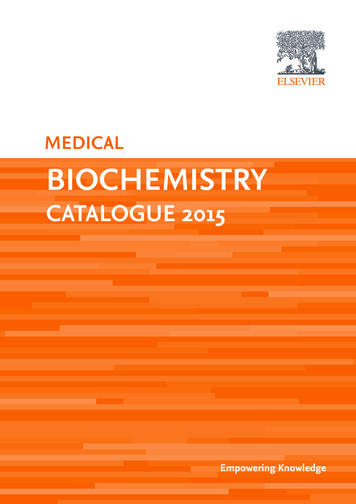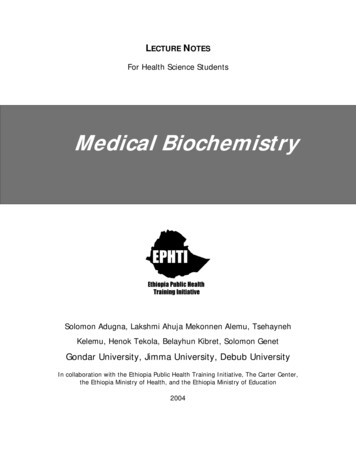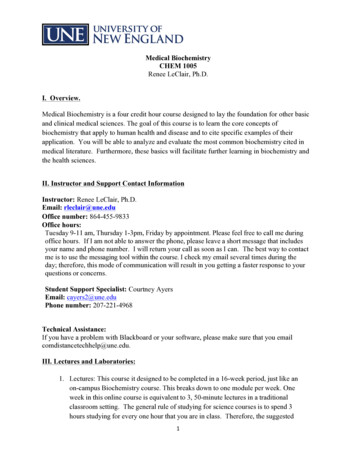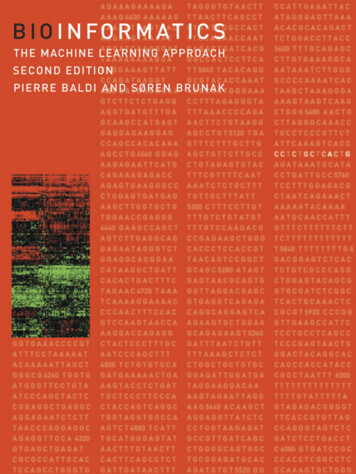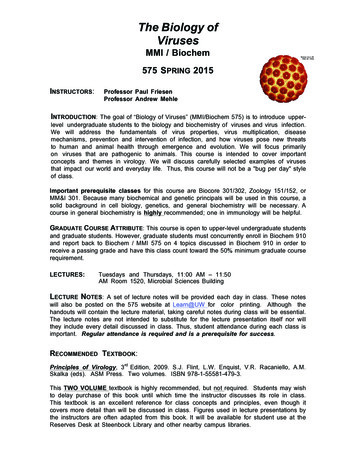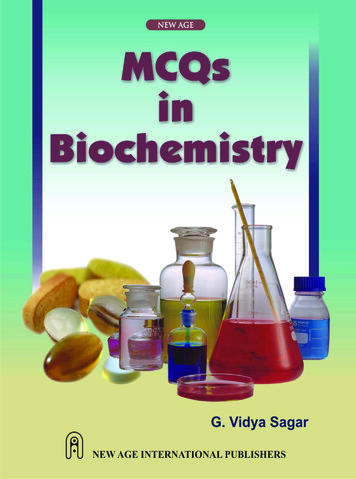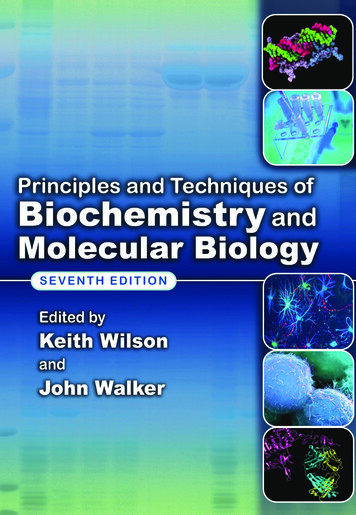
Transcription
Principles and Techniques ofBiochemistry and Molecular BiologySeventh editionEDITED BY KEITH WILSON AND JOHN WALKERThis new edition of the bestselling textbook integrates the theoretical principles and experimentaltechniques common to all undergraduate courses in the bio- and medical sciences. Three of the16 chapters have new authors and have been totally rewritten. The others have been updated andextended to reflect developments in their field exemplified by a new section on stem cells. Two newchapters have been added. One on clinical biochemistry discusses the principles underlying the diagnosisand management of common biochemical disorders. The second one on drug discovery and developmentillustrates how the principles and techniques covered in the book are fundamental to the design anddevelopment of new drugs. In-text worked examples are again used to enhance student understandingof each topic and case studies are selectively used to illustrate important examples. Experimentaldesign, quality assurance and the statistical analysis of quantitative data are emphasised throughoutthe book. Motivates students by including cutting-edge topics and techniques, such as drug discovery,as well as the methods they will encounter in their own lab classesPromotes problem solving by setting students a challenge and then guiding them throughthe solutionIntegrates theory and practise to ensure students understand why and how each techniqueis used.K E I T H W I L S O N is Professor Emeritus of Pharmacological Biochemistry and former Head of theDepartment of Biosciences, Dean of the Faculty of Natural Sciences, and Director of Research at theUniversity of Hertfordshire.J O H N W A L K E R is Professor Emeritus and former Head of the School of Life Sciences at theUniversity of Hertfordshire.
Cover illustrationMain image Electrophoresis gel showing recombinant protein. Photographer: J.C. Revy. Courtesy ofScience Photo Library.Top inset Transcription factor and DNA molecule. Courtesy of: Laguna Design/Science Photo Library.Second inset Microtubes, pipettor (pipette) tip & DNA sequence. Courtesy of Tek Image/SciencePhoto Library.Third inset Stem cell culture, light micrograph. Photographer: Philippe Plailly. Courtesy of SciencePhoto Library.Fourth inset Embryonic stem cells. Courtesy of Science Photo Library.Bottom inset Herceptin breast cancer drug, molecular model. Photographer: Tim Evans. Courtesy ofScience Photo Library.
Principles and Techniques ofBiochemistry andMolecular BiologySeventh editionEdited byKEITH WILSON AND JOHN WALKER
CAMBRIDGE UNIVERSITY PRESSCambridge, New York, Melbourne, Madrid, Cape Town, Singapore,São Paulo, Delhi, Dubai, TokyoCambridge University PressThe Edinburgh Building, Cambridge CB2 8RU, UKPublished in the United States of America byCambridge University Press, New Yorkwww.cambridge.orgInformation on this title: www.cambridge.org/9780521516358First and second editions # Bryan Williams and Keith Wilson 1975, 1981Third edition # Keith Wilson and Kenneth H. Goulding 1986Fourth edition # Cambridge University Press 1993Fifth edition # Cambridge University Press 2000Sixth edition # Cambridge University Press 2005Seventh edition # Cambridge University Press 2010This publication is in copyright. Subject to statutory exceptionand to the provisions of relevant collective licensing agreements,no reproduction of any part may take place withoutthe written permission of Cambridge University Press.First published by Edward Arnold 1975 as A Biologist’s Guide to Principles and Techniques of PracticalBiochemistrySecond edition 1981; Third edition 1986Third edition first published by Cambridge University Press 1992; Reprinted 1993Fourth edition published by Cambridge University Press 1994 as Principles and Techniques of PracticalBiochemistry; Reprinted 1995, 1997; Fifth edition 2000Sixth edition first published by Cambridge University Press 2005 as Principles and Techniques of Biochemistryand Molecular Biology; Reprinted 2006, 2007Seventh edition first published by Cambridge University Press 2010Printed in the United Kingdom at the University Press, CambridgeA catalogue record for this publication is available from the British LibraryLibrary of Congress Cataloging-in-Publication DataPrinciples and techniques of biochemistry and molecular biology / edited by Keith Wilson,John Walker. – 7th ed.p. cm.ISBN 978-0-521-51635-8 (hardback) – ISBN 978-0-521-73167-6 (pbk.)1. Biochemistry–Textbooks. 2. Molecular biology–Textbooks. I. Wilson, Keith, 1936–John M., 1948– III. Title.QP519.7.P75 20096120 .015–dc22 2009043277ISBN 978-0-521-51635-8 HardbackISBN 978-0-521-73167-6 PaperbackCambridge University Press has no responsibility for the persistence oraccuracy of URLs for external or third-party internet websites referred toin this publication, and does not guarantee that any content on suchwebsites is, or will remain, accurate or appropriate.II. Walker,
CONTENTSPreface to the seventh editionList of contributorsList of abbreviations1 Basic principlespage xixiiixv1K. WILSON1.11.21.31.41.51.6Biochemical and molecular biology studiesUnits of measurementWeak electrolytesQuantitative biochemical measurementsSafety in the laboratorySuggestions for further reading2 Cell culture techniques13616353738A. R. BAYDOUN2.12.22.32.42.52.62.72.82.9IntroductionThe cell culture laboratory and equipmentSafety considerations in cell cultureAseptic techniques and good cell culture practiceTypes of animal cell, characteristics and maintenance in cultureStem cell cultureBacterial cell culturePotential use of cell culturesSuggestions for further reading3 Centrifugation38394344496168717273K . O H L EN D I EC K3.13.23.33.43.53.6vIntroductionBasic principles of sedimentationTypes, care and safety aspects of centrifugesPreparative centrifugationAnalytical centrifugationSuggestions for further reading737479869599
viContents4 Microscopy100S. W. PADDOCK4.14.24.34.44.54.64.74.8IntroductionThe light microscopeOptical sectioningImaging living cells and tissuesMeasuring cellular dynamicsThe electron microscope (EM)Image archivingSuggestions for further reading5 Molecular biology, bioinformatics and basic techniques100103116123126129133136138R. ductionStructure of nucleic acidsGenes and genome complexityLocation and packaging of nucleic acidsFunctions of nucleic acidsThe manipulation of nucleic acids – basic tools and techniquesIsolation and separation of nucleic acidsMolecular biology and bioinformaticsMolecular analysis of nucleic acid sequencesThe polymerase chain reaction (PCR)Nucleotide sequencing of DNASuggestions for further reading6 Recombinant DNA and genetic analysis138139145149152162164170171178187194195R. ductionConstructing gene librariesCloning vectorsHybridisation and gene probesScreening gene librariesApplications of gene cloningExpression of foreign genesAnalysing genes and gene expressionAnalysing whole genomesPharmacogenomicsMolecular biotechnology and applicationsSuggestions for further reading7 Immunochemical . BURNS7.1 Introduction7.2 Making antibodies263273
ntentsImmunoassay formatsImmuno microscopyLateral flow devicesEpitope mappingImmunoblottingFluorescent activated cell sorting (FACS)Cell and tissue staining techniquesImmunocapture polymerase chain reaction (PCR)Immunoaffinity chromatography (IAC)Antibody-based biosensorsTherapeutic antibodiesThe future uses of antibody technologySuggestions for further reading2832912912922932932942952952962972992998 Protein structure, purification, characterisationand function analysis300J. WALKER8.18.28.38.48.58.6Ionic properties of amino acids and proteinsProtein structureProtein purificationProtein structure determinationProteomics and protein functionSuggestions for further reading9 Mass spectrometric techniques300304307328340351352A. onMass analysersDetectorsStructural information by tandem mass spectrometryAnalysing protein complexesComputing and database analysisSuggestions for further reading10 Electrophoretic techniques352354359377379390394397399J. WALKER10.110.210.310.410.510.610.7General principlesSupport mediaElectrophoresis of proteinsElectrophoresis of nucleic acidsCapillary electrophoresisMicrochip electrophoresisSuggestions for further reading399403407422427431432
viiiContents11 Chromatographic techniques433K. nciples of chromatographyChromatographic performance parametersHigh-performance liquid chromatographyAdsorption chromatographyPartition chromatographyIon-exchange chromatographyMolecular (size) exclusion chromatographyAffinity chromatographyGas chromatographySuggestions for further reading12 Spectroscopic techniques: I Spectrophotometric techniques433435446453455459462465470476477A. nUltraviolet and visible light spectroscopyFluorescence spectroscopyLuminometryCircular dichroism spectroscopyLight scatteringAtomic spectroscopySuggestions for further reading13 Spectroscopic techniques: II Structure and interactions477482493507509514516519522A. nInfrared and Raman spectroscopySurface plasmon resonanceElectron paramagnetic resonanceNuclear magnetic resonanceX-ray diffractionSmall-angle scatteringSuggestions for further reading14 Radioisotope techniques522523527530536546549551553R. J. SLATER14.114.214.314.414.514.6Why use a radioisotope?The nature of radioactivityDetection and measurement of radioactivityOther practical aspects of counting of radioactivity and analysis of dataSafety aspectsSuggestions for further reading553554561573577580
ixContents15 Enzymes581K. WILSON15.115.215.315.415.515.6Characteristics and nomenclatureEnzyme steady-state kineticsAnalytical methods for the study of enzyme reactionsEnzyme active sites and catalytic mechanismsControl of enzyme activitySuggestions for further reading16 Principles of clinical biochemistry581584602611615624625J . F Y F F E A N D K . W I L S ON16.116.216.316.416.5Principles of clinical biochemical analysisClinical measurements and quality controlExamples of biochemical aids to clinical diagnosisSuggestions for further readingAcknowledgements62562964065865917 Cell membrane receptors and cell signalling660K. WILSON17.117.217.317.417.517.6Receptors for cell signallingQuantitative aspects of receptor–ligand bindingLigand-binding and cell-signalling studiesMechanisms of signal transductionReceptor traffickingSuggestions for further reading18 Drug discovery and development660663680685703707709K. WILSON18.118.218.318.4Human disease and drug therapyDrug discoveryDrug developmentSuggestions for further reading709718727734Index736The colour figure section is between pages 128 and 129
PREFACE TO THE SEVENTH EDITIONIn designing the content of this latest edition we continued our previous policy ofplacing emphasis on the recommendations we have received from colleagues andacademics outside our university. Above all, we have attempted to respond to theinvaluable feedback from student users of our book both in the UK and abroad. In thisseventh edition we have retained all 16 chapters from the previous edition. All havebeen appropriately updated to reflect recent developments in their fields, as exemplifiedby the inclusion of a section on stem cells in the cell culture chapter. Three of thesechapters have new authors and have been completely rewritten. Robert Burns, ScottishAgricultural Science Agency, Edinburgh has written the chapter on immunochemicaltechniques, and Andreas Hofmann, Eskitis Institute of Molecular Therapies, GriffithUniversity, Brisbane, Australia has written the two chapters on spectroscopictechniques. We are delighted to welcome both authors to our team of contributors.In addition to these changes of authors, two new chapters have been added to thebook. Our decision taken for the sixth edition to include a section on the biochemicalprinciples underlying clinical biochemistry has been well received and so we haveextended our coverage of the subject and have devoted a whole chapter (16) to thissubject. Written in collaboration with Dr John Fyffe, Consultant Biochemist, RoyalHospital for Sick Children, Yorkhill, Glasgow, new topics that are discussed in thechapter include the diagnosis and management of kidney disease, diabetes, endocrinedisorders including thyroid dysfunction, conditions of the hypothalamus–pituitary–adrenal axis such as pregnancy, and pathologies of plasma proteins such as myeloma.Case studies are included to illustrate how the principles discussed apply to thediagnosis and treatment of individual patients with the conditions.Our second major innovation for this new edition is the introduction of a newchapter on drug discovery and development. The strategic approaches to the discoveryof new drugs has been revolutionised by developments in molecular biology. Pharmaceutical companies now rely on many of the principles and experimental techniquesdiscussed in the chapters throughout the book to identify potential drug targets,screen chemical libraries and to evaluate the safety and efficacy of selected candidatedrugs. The new chapter illustrates the principles of target selection by reference tocurrent drugs used in the treatment of atherosclerosis and HIV/AIDS, emphasises thestrategic decisions to be taken during the various stages of drug discovery andxi
xiiPreface to the seventh editiondevelopment and discusses the issues involved in clinical trials and the registration ofnew drugs.We continue to welcome constructive comments from all students who use ourbook as part of their studies and academics who adopt the book to complement theirteaching. Finally, we wish to express our gratitude to the authors and publishers whohave granted us permission to reproduce their copyright figures and our thanks toKatrina Halliday and her colleagues at Cambridge University Press who have been sosupportive in the production of this new edition.KEITH WILSON AND JOHN WALKER
CONTRIBUTORSPROFESSOR A. AITKENDivision of Biomedical & Clinical Laboratory SciencesUniversity of EdinburghGeorge SquareEdinburgh EH8 9XDScotland, UKD R A . R . B A Y D O UNSchool of Life SciencesUniversity of HertfordshireCollege LaneHatfieldHerts AL10 9AB, UKDR R. BURNSScottish Agricultural Science Agency1 Roddinglaw RoadEdinburgh EH12 9FJScotland, UKDR J. FYFFEConsultant Clinical BiochemistDepartment of Clinical BiochemistryRoyal Hospital for Sick ChildrenYorkhillGlasgow G3 8SFScotland, UKPROFESSOR ANDREAS HOFMANNStructural ChemistryEskitis Institute for Cell & Molecular TherapeuticsGriffith UniversityNathanBrisbane, Qld 4111Australiaxiii
xivList of contributorsP R O F E S S O R K . OH L EN D I EC KDepartment of BiologyNational University of IrelandMaynoothCo. KildareIrelandDR S. W. PADDOCKHoward Hughes Medical InstituteDepartment of Molecular BiologyUniversity of Wisconsin1525 Linden DriveMadison, WI 53706USADR R. RAPLEYSchool of Life SciencesUniversity of HertfordshireCollege LaneHatfieldHerts AL10 9AB, UKPROFESSOR R. J. SLATERSchool of Life SciencesUniversity of HertfordshireCollege LaneHatfieldHerts AL10 9AB, UKPROFESSOR J. M. WALKERSchool of Life SciencesUniversity of HertfordshireCollege LaneHatfieldHerts AL10 9AB, UKP R O F E S S O R K . W I L S ONEmeritus Professor of Pharmacological BiochemistrySchool of Life SciencesUniversity of HertfordshireCollege LaneHatfieldHerts AL10 9AB, UK
ABBREVIATIONSThe following abbreviations have been used throughout this book.AMPADPATPbpcAMPCHAPSc.p.m.CTPDDTDMSODNAe ADþNADHNADPþNADPHPipesxvadenosine 50 -monophosphateadenosine 50 -diphosphateadenosine 50 -triphosphatebase-pairscyclic esulphonic acidcounts per minutecytidine roethanedimethylsulphoxidedeoxyribonucleic ked immunosorbent assayflavin adenine dinucleotide (oxidised)flavin adenine dinucleotide (reduced)flavin mononucleotide (oxidised)flavin mononucleotide (reduced)gas chromatographyguanosine triphosphatehypoxanthine, aminopterin, thymidine ic acidhigh-performance liquid chromatographykilobase-pairsrelative molecular massminutenicotinamide adenine dinucleotide (oxidised)nicotinamide adenine dinucleotide (reduced)nicotinamide adenine dinucleotide phosphate (oxidised)nicotinamide adenine dinucleotide phosphate (reduced)1,4-piperazinebis(ethanesulphonic acid)
xviPip.p.m.p.p.b.PPiRNAr.p.m.SDSTrisList of abbreviationsinorganic phosphateparts per millionparts per billioninorganic pyrophosphateribonucleic acidrevolutions per minutesodium dodecyl sulphate2-amino-2-hydroxymethylpropane-1,3-diol
1 Basic principlesK. WILSON1.11.21.31.41.51.6Biochemical and molecular biology studiesUnits of measurementWeak electrolytesQuantitative biochemical measurementsSafety in the laboratorySuggestions for further reading1.1 BIOCHEMICAL AND MOLECULAR BIOLOGY STUDIES1.1.1 Aims of laboratory investigationsBiochemistry involves the study of the chemical processes that occur in living organisms with the ultimate aim of understanding the nature of life in molecular terms.Biochemical studies rely on the availability of appropriate analytical techniques and onthe application of these techniques to the advancement of knowledge of the nature of,and relationships between, biological molecules, especially proteins and nucleic acids,and cellular function. In recent years huge advances have been made in our understanding of gene structure and expression and in the application of techniques such asmass spectrometry to the study of protein structure and function. The Human GenomeProject in particular has been the stimulus for major developments in our understanding of many human diseases especially cancer and for the identification of strategiesthat might be used to combat these diseases. The discipline of molecular biologyoverlaps with that of biochemistry and in many respects the aims of the two disciplinescomplement each other. Molecular biology is focussed on the molecular understandingof the processes of replication, transcription and translation of genetic materialwhereas biochemistry exploits the techniques and findings of molecular biology toadvance our understanding of such cellular processes as cell signalling and apoptosis.The result is that the two disciplines now have the opportunity to address issues such as: 1the structure and function of the total protein component of the cell (proteomics) andof all the small molecules in the cell (metabolomics);the mechanisms involved in the control of gene expression;
2Basic principles the identification of genes associated with a wide range of human diseases;the development of gene therapy strategies for the treatment of human diseases;the characterisation of the large number of ‘orphan’ receptors, whose physiologicalrole and natural agonist are currently unknown, present in the human genomeand their exploitation for the development of new therapeutic agents;the identification of novel disease-specific markers for the improvement of clinicaldiagnosis;the engineering of cells, especially stem cells, to treat human diseases;the understanding of the functioning of the immune system in order to developstrategies for the protection against invading pathogens;the development of our knowledge of the molecular biology of plants in order toengineer crop improvements, pathogen resistance and stress tolerance;the application of molecular biology techniques to the nature and treatment ofbacterial, fungal and viral diseases. The remaining chapters in this book address the major experimental strategies andanalytical techniques that are routinely used to address issues such as these.1.1.2 Experimental designAdvances in biochemistry and molecular biology, as in all the sciences, are based onthe careful design, execution and data analysis of experiments designed to addressspecific questions or hypotheses. Such experimental design involves a discretenumber of compulsory stages: the identification of the subject for experimental investigation;the critical evaluation of the current state of knowledge (the ‘literature’) ofthe chosen subject area noting the strengths and weaknesses of the methodologiespreviously applied and the new hypotheses which emerged from the studies;the formulation of the question or hypothesis to be addressed by the plannedexperiment;the careful selection of the biological system (species, in vivo or in vitro) to be used forthe study;the identification of the variable that is to be studied; the consideration of the othervariables that will need to be controlled so that the selected variable is the only factorthat will determine the experimental outcome;the design of the experiment including the statistical analysis of the results, carefulevaluation of the materials and apparatus to be used and the consequential potentialsafety aspects of the study;the execution of the experiment including appropriate calibrations and controls, witha carefully written record of the outcomes;the replication of the experiment as necessary for the unambiguous analysis of theoutcomes;
31.2 Units of measurement the evaluation of the outcomes including the application of appropriate statisticaltests to quantitative data where applicable;the formulation of the main conclusions that can be drawn from the results;the formulation of new hypotheses and of future experiments that emerge fromthe study. The results of well-designed and analysed studies are finally published in the scientificliterature after being subject to independent peer review, and one of the majorchallenges facing professional biochemists and molecular biologists is to keep abreastof current advances in the literature. Fortunately, the advent of the web has madeaccess to the literature easier than it once was.1.2 UNITS OF MEASUREMENT1.2.1 SI unitsThe French Système International d0 Unités (the SI system) is the accepted conventionfor all units of measurement. Table 1.1 lists basic and derived SI units. Table 1.2 listsnumerical values for some physical constants in SI units. Table 1.3 lists the commonlyused prefixes associated with quantitative terms. Table 1.4 gives the interconversionof non-SI units of volume.1.2.2 Molarity – the expression of concentrationIn practical terms one mole of a substance is equal to its molecular mass expressed ingrams, where the molecular mass is the sum of the atomic masses of the constituentatoms. Note that the term molecular mass is preferred to the older term molecularweight. The SI unit of concentration is expressed in terms of moles per cubic metre(mol m 3) (see Table 1.1). In practice this is far too large for normal laboratorypurposes and a unit based on a cubic decimetre (dm3, 10 3 m) is preferred. However,some textbooks and journals, especially those of North American origin, tend to use theolder unit of volume, namely the litre and its subunits (see Table 1.4) rather than cubicdecimetres. In this book, volumes will be expressed in cubic decimetres or its smallercounterparts (Table 1.4). The molarity of a solution of a substance expresses the numberof moles of the substance in one cubic decimetre of solution. It is expressed by thesymbol M.It should be noted that atomic and molecular masses are both expressed in daltons(Da) or kilodaltons (kDa), where one dalton is an atomic mass unit equal to onetwelfth of the mass of one atom of the 12C isotope. However, biochemists prefer to usethe term relative molecular mass (Mr). This is defined as the molecular mass of asubstance relative to one-twelfth of the atomic mass of the 12C isotope. Mr thereforehas no units. Thus the relative molecular mass of sodium chloride is 23 (Na) plus
4Basic principlesTable 1.1 SI units – basic and derived unitsSI unitSymbol(basic SI units)Definitionof SI unitEquivalentin SI unitsLengthmetremMasskilogramkgTimesecondsElectric currentampereATemperaturekelvinKLuminous intensitycandelacdAmount ofsubstancemolemolForcenewtonNkg m s 2J m 1Energy, work, heatjouleJkg m2 s 2NmPower, radiant fluxwattWkg m2 s 3J s 1Electric charge,quantitycoulombCAsJ V 1Electric potentialdifferencevoltVkg m2 s 3A 1J C 1Electric resistanceohmOkg m2 s 3A 2V A 1PressurepascalPakg m 1 s 2N m 2FrequencyhertzHzs 1Magnetic fluxdensityteslaTkg s 2 A 1Areasquare metrem2Volumecubic metrem3Densitykilogram percubic metrekg m 3Concentrationmole per cubicmetremol m 3QuantityBasic unitsDerived unitsOther units based on SIV s m 2
51.2 Units of measurementTable 1.2 SI units – conversion factors for non-SI unitsUnitSymbolSI equivalentAvogadro constantL or NA6.022 1023 mol 1Faraday constantF9.648 104 C mol 1Planck constanth6.626 10 34 J sUniversal or molar gas constantR8.314 J K 1 mol 122.41 dm3 mol 1Molar volume of an ideal gas at s.t.p.c2.997 108 m s 1caloriecal4.184 Jergerg10 7 Jelectron volteV1.602 10 19 Jatmosphereatm101 325 Pabarbar105 Pamillimetres of Hgmm Hg133.322 Pacentigrade C(t C þ 273.15) KFahrenheit F(t F – 32)5/9 þ 273.15 KVelocity of light in a ̊10 10 minchin0.0254 mlb0.4536 kgMasspoundNote: s.t.p., standard temperature and pressure.35.5 (Cl) i.e. 58.5, so that one mole is 58.5 grams. If this was dissolved in water andadjusted to a total volume of 1 dm3 the solution would be one molar (1 M).Biological substances are most frequently found at relatively low concentrationsand in in vitro model systems the volumes of stock solutions regularly used forexperimental purposes are also small. The consequence is that experimental solutionsare usually in the mM, mM and nM range rather than molar. Table 1.5 shows theinterconversion of these units.
6Basic principlesTable 1.3 Common unit prefixes associated with quantitative 4yottaY10 1decid1021zettaZ10 2centic1018exaE10 3millim 615petaP10microm1012teraT10 9nanon109gigaG10 12picop106megaM10 15femtof103 18kilok10attoa102hectoh10 21zeptoz101decada10 24yoctoy10Table 1.4 Interconversion of non-SI and SI units of volumeNon-SI unitNon-SI subunitSI subunitSI unit1 litre (l)103 ml¼ 1 dm3¼ 10 3 m31 millilitre (ml)1 ml¼ 1 cm3¼ 10 6 m31 microlitre (ml)10 3 ml¼ 1 mm3¼ 10 9 m31 nanolitre (nl)10 6 ml¼ 1 nm3¼ 10 12 m3Table 1.5 Interconversion of mol, mmol and mmol in different volumesto give different concentrationsMolar (M)Millimolar (mM)Micromolar (mM)1 mol dm 31 mmol dm 31 mmol dm 31 mmol cm 31 mmol cm 31 nmol cm 31 mmol mm 31 nmol mm 31 pmol mm 31.3 WEAK ELECTROLYTES1.3.1 The biochemical importance of weak electrolytesMany molecules of biochemical importance are weak electrolytes in that they areacids or bases that are only partially ionised in aqueous solution. Examples include
71.3 Weak electrolytesthe amino acids, peptides, proteins, nucleosides, nucleotides and nucleic acids. It alsoincludes the reagents used in the preparation of buffers such as ethanoic (acetic) acidand phosphoric acid. The biochemical function of many of these molecules is dependent upon their precise state of ionisation at the prevailing cellular or extracellular pH.The catalytic sites of enzymes, for example, contain functional carboxyl and aminogroups, from the side chains of constituent amino acids in the protein chain, whichneed to be in a specific ionised state to enable the catalytic function of the enzyme tobe realised. Before the ionisation of these compounds is discussed in detail, it isnecessary to appreciate the importance of the ionisation of water.1.3.2 Ionisation of weak acids and basesOne of the most important weak electrolytes is water since it ionises to a small extent togive hydrogen ions and hydroxyl ions. In fact there is no such species as a free hydrogenion in aqueous solution as it reacts with water to give a hydronium ion (H3Oþ):H2 OÐHþ þ HO Hþ þ H2 OÐH3 OþEven though free hydrogen ions do not exist it is conventional to refer to them ratherthan hydronium ions. The equilibrium constant (Keq) for the ionisation of water has avalue of 1.8 1016 at 24 C:Keq ¼½Hþ ½OH ¼ 1:8 1016½H2 O ð1:1ÞThe molarity of pure water is 55.6 M. This can be incorporated into a new constant,Kw:1:8 10 16 55:6 ¼ ½Hþ ½HO ¼ 1:0 10 14 ¼ Kwð1:2ÞKw is known as the autoprotolysis constant of water and does not include anexpression for the concentration of water. Its numerical value of exactly 10 14 relatesspecifically to 24 C. At 0 C Kw has a value of 1.14 10 15 and at 100 C a value of5.45 10 13. The stoichiometry in equation 1.2 shows that hydrogen ions andhydroxyl ions are produced in a 1 : 1 ratio, hence both of them must be present at aconcentration of 1.0 10 7 M. Since the Sörensen definition of pH is that it is equal tothe negative logarithm of the hydrogen ion concentration, it follows that the pH ofpure water is 7.0. This is the definition of neutrality.Ionisation of carboxylic acids and aminesAs previously stressed, many biochemically important compounds contain a carboxylgroup (-COOH) or a primary (RNH2), secondary (R2NH) or tertiary (R3N) amine whichcan donate or accept a hydrogen ion on ionisation. The tendency of a weak acid,generically represented as HA, to ionise is expressed by the equilibrium reaction:HAÐ Hþ þA weak acidconjugate base ðanionÞ
8Basic principlesThis reversible reaction can be represented by an equilibrium constant, Ka, known asthe acid dissociation constant (equation 1.3). Numerically, it is very small.Ka ¼½Hþ ½A ½HA ð1:3ÞNote that the ionisation of a weak acid results in the release of a hydrogen ion and theconjugate base of the acid, both of which
Biochemistry and Molecular Biology Seventh edition EDITED BY KEITH WILSON AND JOHN WALKER This new edition of the bestselling textbook integrates the theoretical principles and experimental techniques common to all undergraduate courses in the bio- and medical sciences. Three of the 16 c
